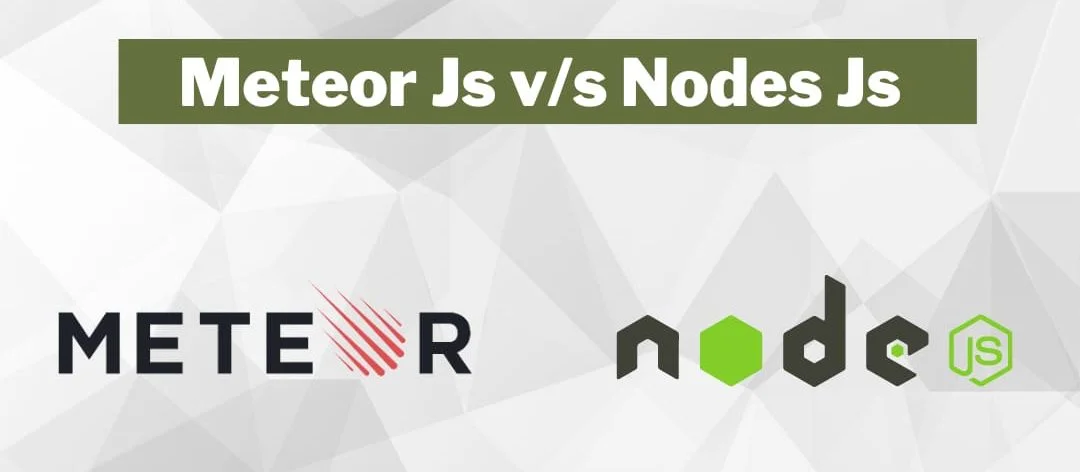The technology market is flooded with several tech stacks that are focused on making the website and mobile App development process extremely seamless. Several tech stacks have been introduced by the experts and now there seems to be a battle between all these tech stacks that makes it quite tricky for developers to pick the right development buddy. Similarly, the debate between the popular development frameworks namely Meteor Js and Node Js has been taking a vibrant turn. So, let’s understand what these technologies are and how they differ.
Basic Understanding of Meteor JS and Nodes Js
Meteor Js is an open-source, do- it –all framework for making Javascript applications. This means making websites in HTML, CSS, and JavaScript for PC or mobile phones has become quite convenient. By default, while we do “meteor create myapp and cd myapp or meteor run, then all these serve as HTML or Javascript web pages with either Node or Mongo DB on the backend.
On the other hand Node. JS is simply the name of the Javascript that resides on the server end. It is also an open–source, cross-platform Javascript runtime environment with an extensive library to run web applications even outside the client’s browser. Thus, a developer uses it as the server-side web application which is suitable for data–intensive applications and is backed by the event–driven model.
Features of Meteor JS and Nodes JS
Both these open–source web frameworks have advanced features for software development making them a close substitute for each other.
Meteors JS
• Meteor Js framework is good at integration as it allows the integration of different packages.
• It is a great tool for beginners as it facilitates a simple App development process.
• The diverse community of Meteors contributors makes the framework very resilient.
• It is a cross–platform framework and allows making all the implementation of the App in one place.
• It is built using MongoDB handlers, thus providing support for Graph QL.
• Thus, Meteors JS is considered an effective framework that can cut the development time and facilitate easy App maintenance.
Nodes JS
• It runs the V8 Javascript engine which is the core of Google Chrome and thus is very performant.
• Nodes JS runs in a single process without creating multiple threads for each request.
• It is a set of asynchronous I/O primitives present in the standard library helps to prevent blockage of Javascript code.
• This framework handles thousands of concurrent connections in a single server without increasing the burden of thread concurrency which usually is a source of bugs.
• Nodes. JS makes it possible to write the server–side code in addition to the client–side code.
Difference Between Meteor JS and Nodes JS
There are certain differences in these development frameworks which are as follows:
Fundamental Approach
Meteors Js is an ultra-simple database referred to as data – on–the–wire, pure–JavaScript framework while Nodes Js uses an event–driven non-blocking I/O model. However, both of these are primarily classified as “Frameworks (Full Stack ) tools.
Compatibility with Web Browser
The Meteor application is a mix of JavaScript which operates inside the client web browser, JavaScript running on the Meteor server inside a Node.js container, and supports CSS rules, static assets, and HTML fragments. On contrary, this platform is built on Chrome’s Javascript runtime which builds fast and scalable network applications.
Developer’s Preference
The key factors of Meteors JS such as “Real time processing”, “Full stack language” and “Suitable Application Development Attributes” make Meteor the choice of developers globally. On the other hand, the “extensive libraries” and “Npm extension” are the primary reason why developers favor Nodes.JS
Community Strength
Both of these frameworks are popular open–source frameworks. The Meteor JS had around 41.2K stars and 5.03K forks on Github whereas Nodes.js had comparatively lesser but significant 35.5K starts and 7.78K forks on Github. Alongside, on StackShare Node.JS has broader approval with 4102 company stacks and 4028 developer stacks whereas the Meteors was listed only in 195 company stacks and 156 developer stacks for the last few years.
Final Words
Both these frameworks are highly versatile and advanced. Node.JS is the server–side framework that provides lightweight and flexible development even with a limited number of features. However. Meteor is highly automated and encourages fast prototyping and building MVP (Minimum Viable Products). Thus, the adoption of Meteor.JS is growing at a faster pace.





